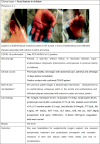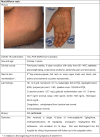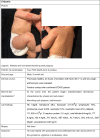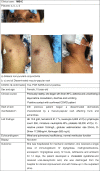Cutaneous Manifestations Related to COVID-19 Immune Dysregulation in the Pediatric Age Group
- PMID: 33630167
- PMCID: PMC7905763
- DOI: 10.1007/s11882-020-00986-6
Cutaneous Manifestations Related to COVID-19 Immune Dysregulation in the Pediatric Age Group
Abstract
Purpose of review: At the juncture of the COVID-19 pandemic, the world is currently in an early phase of collecting clinical data and reports of its skin manifestations, and its pathophysiology is still highly conjectural. We reviewed cutaneous manifestations associated with COVID-19 in the pediatric age group.
Recent findings: Children infected by SARS-CoV-2 usually develop milder respiratory symptoms, but cutaneous manifestations seem a little more prevalent than in adults. These skin features of infection by the coronavirus can be similar to those produced by other common viruses, but there are also reports of cases with more heterogeneous clinical pictures, which have made their classification difficult. To date, the more frequently reported skin variants featured in pediatric cases are purpuric (pseudo-chilblain, necrotic-acral ischemia, hemorrhagic macules, and/or cutaneous necrosis), morbilliform/maculopapular, erythema multiforme, urticarial, vesicular, Kawasaki-like, and miscellaneous (highly variable in both frequency and severity). Their pathophysiological mechanism is still elusive and is likely to be the result of the complex involvement of one or more mechanisms, like direct virus-induced skin damage, vasculitis-like reactions, and/or indirect injury as a consequence of a systemic inflammatory reaction. In this review, we presented and discussed clinical cases as examples of different cutaneous responses reported in some children with SARS-CoV-2 infection, differential diagnosis considerations, and a preliminary conceptual approach to some of their probable associated pathologic mechanisms.
Keywords: COVID-19, pediatric; Kawasaki-like; Pseudo-chilblain; Purpuric lesion; SARS-COV-2.
Conflict of interest statement
The authors declare no conflicts of interest relevant to this manuscript.
Figures








References
-
- WHO Director-General's opening remarks at the media briefing on COVID-19 - 11 March 2020: World Health Organization; 2020 [Available from: https://www.who.int/dg/speeches/detail/who-director-general-s-opening-re....
-
- • DGE. Covid-19 México: CONACYT - CentroGeo - GeoInt - DataLab; 2020 [updated August 16th, 2020. Available from: https://coronavirus.gob.mx/datos/. Official database of the Mexican government on health statistics related to COVID-19, sorted by age group.
-
- •• Recalcati S. Cutaneous manifestations in COVID-19: a first perspective. J Eur Acad Dermatol Venereol. 2020. First publication on dermatologic manifestations related to COVID-19 (all in adults). - PubMed
Publication types
MeSH terms
LinkOut - more resources
Full Text Sources
Other Literature Sources
Medical
Research Materials
Miscellaneous

